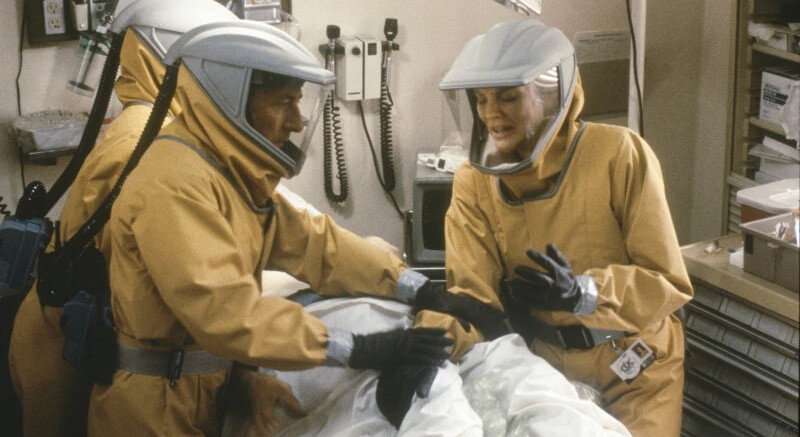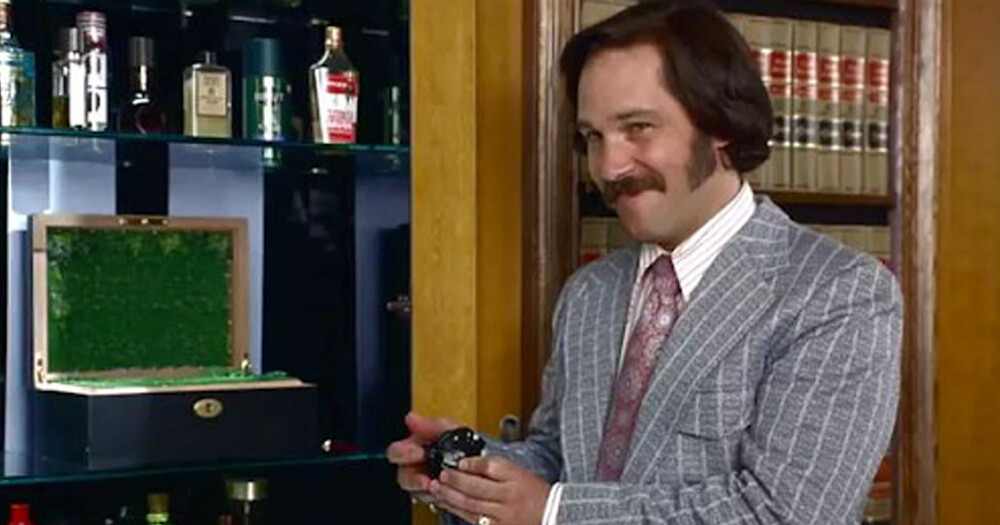4 Science Plots In Movies That Now Look So, So Stupid

These days, everyone’s an armchair epidemiologist, and the average citizen (hopefully) knows way more about disease transmission and mutation than they used to. Last year, the entire planet had to take Biology 101 at the same time, which sounds like a charming scenario on paper.
Anyway, chances are your science knowledge outstrips the following Hollywood flicks, all of which got their science degrees from The University of Milk Duds.
Outbreak: Gotta Cure Fast!
Back around the early days of the pandemic, everyone was thinking about Contagion for a while there. Not nearly as many people were thinking about Outbreak, the sloppy seconds of the “pandemic movie full of famous people” genre, like the Skype to its Zoom.
Contagion followed a fictional disease that spread all around the world, but Outbreak spends most of its time in one small town in California, and tracks the doctors and scientists working to contain the virus before the military decides to destroy the town to cover it up, or the virus makes like the most attractive kid in a small town and moves to LA.
Our heroes manage to develop a cure in the nick of time, a procedure which involves helicopter chases and action-movie one liners way more than it does clinical trials or gene analysis.

Warner Bros.
What It Gets Wrong:
Sadly, most of the really inaccurate stuff about the movie is the part where the heroes save the day and give the movie a happy ending. In real life, the entire procedure of being able to analyze the virus enough to understand what it’s doing, let alone create a cure, took months and months with 2020s levels of medical technology and coordination between basically every lab in the world.
Even today, there’s still quite a lot of trivia about COVID-19 that doctors are kind of clueless about, just because it hasn’t even been two years since the disease was first identified. It makes sense if you think about it: How old are you, and have you figured out what your whole deal is yet?
Meanwhile, in this movie, the heroic team of a few brave doctors is able to come up with a cure that doesn’t only stop the virus but a brand new mutation of it, just a couple days after identifying that mutation. Why? Because this is the kind of 90s movie where everything in the world has to be perfect by the time the credits roll.

Warner Bros.
Does It Get Anything Right?
The movie gets a lot of the smaller details wrong in a very “regular movie” way: misidentifying species, showing doctors not following proper sterilization protocols so they can have more dramatic scenes, and so on. Also, in another bit of realism, Kevin Spacey makes some errors.

Warner Bros.
Hobbs And Shaw: Just Reach In There And Get The Virus Out
So much about the movie industry has changed in reaction to the pandemic. It’s odd to think that just a couple years ago, movies were so dominant that they got away with a Fast and Furious movie that was only kind of a Fast and Furious movie.
This isn’t like Star Wars, that created such an exciting world onscreen that you could tell anyone’s story: The whole thing with F&F is the family, and Hobbs and Shaw is a whole movie about Jason Statham and The Rock as the two people who have the least amount of interest in being part of that family getting their wish and having a whole movie to themselves.

Universal Pictures
Quite appropriate to people who hate the idea of family, the movie is about Shaw’s sister getting infected with a virus that we’re told will melt her organs unless her brother and his equally loud, bald friend can find a special “virus extraction device” for her.
What It Gets Wrong:
Lots of movies have a bad guy who wants to release a deadly virus, but Thomas Hobbes and George Bernard Shaw deserves special attention for putting so much energy and commitment into completely ignoring anything about medicine. For a start, our heroes are on a ticking clock until the virus kills the sister, and when they save her just in the nick of time with that “extraction device," she’s perfectly fine—which is wrong for too many sad reasons to dwell on.
The movie knew even that was on the wrong side of realistic, so it clumsily tries to justify itself by saying that she isn’t actually infected with the virus, she’s infected with “timed-release capsules” that contain the virus, and are going to open when the clock runs out. We suppose the idea is like taking your melatonin except you die a painful, ravaged death instead of getting to sleep.
The “extraction device” is similarly bullshit—it’s removing those capsules, not just taking the virus out with magical technology, but they never really bother to cover how, and it’s probably for the best. Whatever you think about vaccines, medical science has definitely not progressed to a little Fantastic Voyage janitor that goes into the bloodstream and sweeps, mops and buffs each viral cell until everything’s clean.

Universal Pictures
Which is why, when they need to fix it, they go to a chop shop and find a bike mechanic.
Also, while we’re at it, viruses can do a lot of awful stuff to your body, but saying it’ll “melt your organs” just goes to show that you’re just allowed to write stuff and then have famous people say it.
Does It Get Anything Right?
The Rock and Jason Statham definitely seem like two people who would only be capable of showing love for family members by saving them from mortal danger.
Dan Brown’s Inferno: Random Virus Generator
They talk about "popcorn movies," but Dan Brown writes popcorn books: simple writing in short chapters that you can practically inhale one after another, which are really satisfying unless you stop and think about what's going on for literally five seconds. Of course, popcorn has an easier time of keeping your brain shut off, since popcorn doesn't need a plot that advances from kernel to kernel. That's why Inferno, the fourth book in the Da Vinci Code series, keeps things going at Sonic the Hedgehog speeds.
The story starts out as "Professor Tom Hanks has amnesia," then it progresses pretty quickly to "He's been accused of a crime he didn't commit," before spending a while on "He has to delve into secret conspiracies using his art history knowledge yet again"—you'd think after four books, bad guys would realize to not leave an easy-to-follow trail of clues through major European artworks.

Eventually, it turns out he's investigating a plot to release a virus that will destroy a third of the world's population, which is a pretty silly number: It sounds like whoever made the decision looked at Thanos' plan to wipe out 1/2 of all life and decided they'd change the 2 to a 3 to be more impressive, before they remembered how fractions worked.
What It Gets Wrong:
Too many things to list here. Even when you look past how inconsistently dangerous the virus is (at one point it turns a guy’s bones into jelly, but later we hear all it does is cause sterility), we all know how rates of transmission work now, and how much is down to your immune system. The idea that you could specially make a virus that would work on a specific fraction of the population is literally saying "60 percent of the time, it works every time."

DreamWorks
"No, he too has a 33% chance of dying."
"Ok, suspension of disbelief shattered."
To make things sillier, we're told that the 1/3 figure happens because it infects everyone, but has been engineered to "randomly activate" in 33% of people, which is basically saying that it gets people sick using blockchain.
Does It Get Anything Right?
Funny story: The end of this one is the bad guy winning and the virus getting out into the world and ravaging humanity, much like blockchain. Points for realism and not having a happy ending in such a basic potboiler story, though we probably have to deduct those points because the movie actually has a physical Tom Hanks stop the evil plan in time and keep everyone safe.

Columbia Pictures
The Andromeda Strain: My House Is Sick Too!
While we’re on airport bookshelves, let’s go to the next rack over from Dan Brown and take a peek into Michael Crichton. Before he was the Westworld and Jurassic Park guy, his first big hit was The Andromeda Strain, about a virus that scientists try and fail to contain, teaching them a lesson about hubris—otherwise known as the lesson of literally every Michael Crichton novel.

Vintage
Since this is Crichton we’re talking about, there’s a book, a movie and a TV show, but they all follow the theme of a virus that comes from space and mutates so fast that it starts to kill things, not just people, and a scientist who has to stop a nuclear bomb that’s meant to contain the virus but will just spread it wider.
What It Gets Wrong:
You could ask a virologist whether The Andromeda Strain could really happen, and it would be pretty much the same as asking a video game designer if we’re living in a simulation—the whole idea is just inventing too much for the question to be much clearer to an expert, and asking would just confirm how stupid you sound to them.
Everything about the spooky alien virus is theoretically possible, but the whole reason to make it an alien is so it can do stuff nothing on Earth—i.e. nothing known to science—can do. Theoretically a virus could mutate fast enough that it started to eat away at material like plastic and glass, so it could break out of containment like the virus does here, but it’s about as likely as you accomplishing everything you plan to get done today, and we both know how likely that is.
Does It Get Anything Right?
We haven’t seen anyone calling for old-timey A-bombs as a solution to our current woes, but after that “horse dewormer” news cycle, it’s only a matter of time.
Top image: Universal Pictures
